IoT Update Management: The Key To Smarter, Safer, And More Efficient Devices
Hey there, tech enthusiasts! If you're into the world of connected devices, you've probably heard the term "IoT" thrown around a lot lately. But what happens when your IoT devices need an upgrade? That's where IoT update management comes into play. It's like the unsung hero of the smart device world, ensuring your gadgets stay up-to-date, secure, and functioning like a charm.
Now, you might be thinking, "What's the big deal about updates?" Well, let me tell you, it's a pretty huge deal. Think about your smartphone or smart fridge—imagine them running on outdated software. Not only would they be slow and clunky, but they'd also be vulnerable to all sorts of cyber threats. IoT update management is the magic that keeps these devices running smoothly, and today we're diving deep into why it matters so much.
So, whether you're a tech-savvy individual or a business looking to harness the power of IoT, this article is for you. We'll break down everything you need to know about IoT update management, from the basics to the best practices, and even touch on some cool tools and trends. Let's get started!
Read also:Adalberto Martiacutenez Resortes A Celebrated Icon In Mexican Comedy
Table of Contents
- What is IoT Update Management?
- Why Does IoT Update Management Matter?
- A Brief Biography of IoT Update Management
- Challenges in IoT Update Management
- Best Practices for IoT Update Management
- Top Tools for IoT Update Management
- IoT Update Management in Business
- IoT Security and Updates
- Future Trends in IoT Update Management
- Conclusion
What is IoT Update Management?
Alright, let's start with the basics. IoT update management is the process of ensuring that all your connected devices—think smart thermostats, security cameras, wearables, and even industrial sensors—are always running the latest software versions. It's kind of like giving your devices a regular tune-up to keep them running smoothly.
But it's not just about making sure your devices work well. IoT update management also plays a crucial role in securing your devices against cyber threats. With hackers getting smarter by the day, keeping your software up-to-date is one of the best ways to protect your gadgets from unwanted intrusions.
And here's the kicker—IoT update management isn't just for tech geeks or big corporations. It's something that affects everyone who uses smart devices. Whether you're updating your smart home setup or managing a fleet of industrial sensors, good update management practices are essential for keeping everything running like clockwork.
Why Does IoT Update Management Matter?
Now that we know what IoT update management is, let's talk about why it's such a big deal. First off, it's all about performance. Outdated software can slow down your devices, making them clunky and unresponsive. Nobody wants a smart fridge that takes five minutes to tell them they're out of milk, right?
Secondly, there's the security factor. Cyber threats are real, and they're only getting more sophisticated. IoT devices are often seen as easy targets by hackers because they're not always updated as frequently as, say, your computer or smartphone. By keeping your devices up-to-date, you're closing those security loopholes and making it harder for bad actors to mess with your stuff.
Lastly, there's the matter of compliance. Depending on where you live or what industry you're in, there might be regulations that require you to keep your devices updated. Ignoring these rules can lead to hefty fines or even legal trouble. So, yeah, it's kind of a big deal.
Read also:Rick Pitino Opens Up On Benching Rj Luis During St Johns Seasonending Loss In Exclusive Clip
A Brief Biography of IoT Update Management
IoT update management hasn't been around forever, but it's come a long way in a short amount of time. Back in the early days of IoT, device updates were pretty much a manual process. You'd have to connect your device to a computer, download the latest firmware, and then upload it to your device. Tedious, right?
Fast forward to today, and we've got over-the-air (OTA) updates that can be pushed directly to devices without any manual intervention. It's like having a personal tech assistant who makes sure everything is always up-to-date without you even lifting a finger. Cool, huh?
But it's not just about convenience. The evolution of IoT update management has been driven by the growing need for security and efficiency. As more and more devices become connected, the importance of keeping them updated has only increased. And with advancements in cloud computing and AI, we're seeing even smarter ways to manage updates across large networks of devices.
Biography Data
| Aspect | Details |
|---|---|
| Origin | Manual updates in early IoT devices |
| Evolution | Shift to over-the-air (OTA) updates |
| Current State | Cloud-based and AI-driven update management |
| Future | More autonomous and predictive update systems |
Challenges in IoT Update Management
Of course, like anything in life, IoT update management isn't without its challenges. One of the biggest hurdles is scalability. Imagine trying to manage updates for thousands, or even millions, of devices at once. It's not an easy task, and it requires some serious infrastructure and planning.
Then there's the issue of compatibility. Not all devices are created equal, and sometimes updates that work perfectly on one device might cause issues on another. This is where thorough testing and quality assurance come into play. You don't want to push an update that ends up bricking half of your devices, do you?
Lastly, there's the matter of user consent. Some people might not want their devices to update automatically, especially if it means losing custom settings or configurations. Finding the right balance between convenience and user control is a delicate dance that IoT update management systems need to master.
Best Practices for IoT Update Management
So, how do you tackle these challenges? Well, there are a few best practices that can help you manage IoT updates more effectively. First off, make sure you've got a solid testing and validation process in place. This means testing updates on a small group of devices before rolling them out to the entire network.
Another key practice is to use a phased rollout approach. Instead of updating all your devices at once, start with a small batch and gradually expand as you gain confidence in the update's stability. This way, if something goes wrong, you can catch it early and fix it before it affects too many devices.
Lastly, consider giving users some level of control over updates. Maybe let them schedule updates for a time that's convenient for them or allow them to opt-out of certain updates if they prefer. It's all about finding the right balance between automation and user empowerment.
Top Tools for IoT Update Management
Now, let's talk about some of the tools that can help you with IoT update management. There are plenty of options out there, each with its own strengths and weaknesses. Here are a few of the top ones:
- OTA Software Update by Pelion: This tool offers secure and scalable over-the-air updates for IoT devices. It's great for businesses that need to manage updates across large fleets of devices.
- AWS IoT Device Management: Amazon's IoT platform provides robust tools for managing device updates, including support for OTA updates and device monitoring.
- Microsoft Azure IoT Hub: Azure's IoT hub offers a comprehensive solution for managing device updates, with features like automatic rollbacks and update validation.
- Mender: An open-source tool designed specifically for managing updates in embedded Linux systems. It's a great option for businesses looking for a cost-effective solution.
These tools can help streamline your IoT update management processes and make your life a whole lot easier. Whether you're a small startup or a large enterprise, there's a tool out there that can meet your needs.
IoT Update Management in Business
For businesses, IoT update management is more than just a convenience—it's a necessity. In today's fast-paced world, companies can't afford to have outdated or insecure devices. That's why many are turning to IoT update management solutions to keep their operations running smoothly.
Take, for example, a manufacturing company that relies on IoT sensors to monitor equipment performance. If those sensors aren't updated regularly, they might miss critical data that could lead to equipment failures or production downtime. By implementing a robust IoT update management strategy, the company can ensure that its sensors are always up-to-date and functioning as expected.
And it's not just about avoiding problems. Good IoT update management can also lead to better performance and efficiency. Updated devices can take advantage of new features and improvements, which can translate into cost savings and increased productivity. It's a win-win situation for businesses that take IoT update management seriously.
IoT Security and Updates
Let's not forget about security. As we mentioned earlier, IoT devices are often seen as easy targets by hackers. That's why keeping them updated is crucial for maintaining a secure network. But it's not just about patching vulnerabilities—it's also about staying ahead of the curve.
Think of it like this: if you're running a marathon, you don't want to be the last one to cross the finish line. You want to be out in front, setting the pace and leading the pack. In the world of IoT security, that means staying ahead of potential threats by keeping your devices updated with the latest security patches and features.
And here's the thing—security isn't a one-time thing. It's an ongoing process that requires constant vigilance and updates. By making IoT update management a priority, you're not just protecting your devices—you're protecting your entire network and all the data that flows through it.
Future Trends in IoT Update Management
So, what does the future hold for IoT update management? Well, if the past is any indication, we can expect some pretty exciting developments. One trend that's already starting to gain traction is the use of AI and machine learning to predict and automate updates.
Imagine a system that can analyze your device usage patterns and automatically schedule updates at the most convenient times. Or a system that can detect potential issues before they even happen and push out updates to fix them. It's like having a personal tech assistant who knows exactly what your devices need before you even realize it.
Another trend to watch is the rise of edge computing. As more devices move to the edge of the network, update management systems will need to adapt to handle updates in a more decentralized way. This could lead to more efficient and faster updates, as devices won't have to rely on a central server to get their updates.
Conclusion
Well, there you have it—a deep dive into the world of IoT update management. From the basics to the best practices, we've covered a lot of ground today. And if there's one thing we hope you take away from this article, it's the importance of keeping your IoT devices up-to-date.
IoT update management might not be the sexiest topic in tech, but it's one of the most crucial. Whether you're a tech enthusiast or a business looking to harness the power of IoT, good update management practices can make all the difference. So, take the time to learn about the tools and strategies available, and make sure your devices are always running the latest and greatest software.
And don't forget to share this article with your friends and colleagues. The more people who understand the importance of IoT update management, the safer and more efficient our connected world will be. Until next time, stay updated and stay safe!


